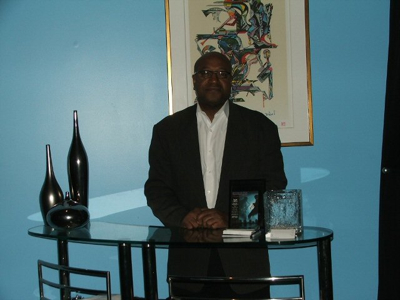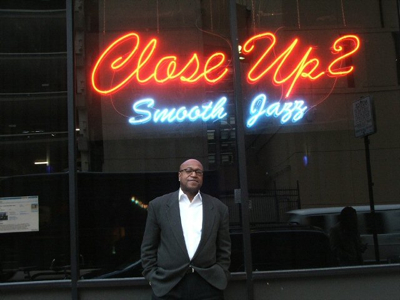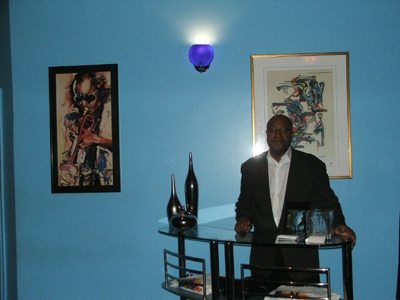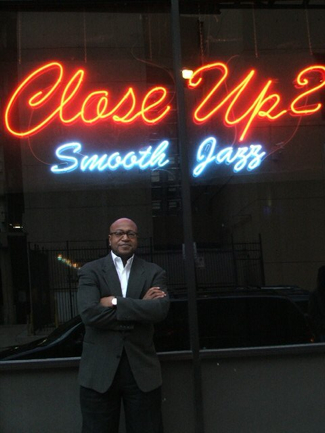Interview & Photos by James Walker Jr.
Recently, James Walker Jr. sat down with Frank Goss, smooth jazz club entrepreneur, for an in-depth interview about the first year of Chicago smooth jazz nightclub - Close Up2.
JC: Frank, give the Jazzchicago readers a glimpse into your background as it pertains to your affinity for smooth jazz. Also, do you have a background in music?
FG: Ok, I have a background in music. I went to Marshall High School and was in the choir and played in the orchestra and the military ROTC band. I then went to Kendall College for two years and took private voice lessons with the assumption that I would become an entertainer. I really wasn't quite sure what I wanted to do.
JC: What instrument did you play?
FG: I played cello and electric bass.
JC: How did that transition into your fondness for contemporary jazz?
FG: I always loved contemporary, cutting-edge music when I was growing up. I always listened to a variety of music like Sly and the Family Stone, Jeff Beck and a variety of musicians from all walks of like. Also, during high school I used to handle the lights for a nightclub called Soul Junction and they had classic jazz. They featured musicians like Gene Ammons and Sonny Stitt. It was also there that I discovered Miles Davisand began studying jazz. I sort of became a Miles Davis disciple and understood his intention of music and how he pushed Jazz into new areas. That's how my appreciation of Jazz evolved.
 JC: Frank, this is your second venture of a smooth jazz club in the financial district. Tell us why you chose this location as opposed to another Chicago area?
JC: Frank, this is your second venture of a smooth jazz club in the financial district. Tell us why you chose this location as opposed to another Chicago area?
FG: Let me just say, I am part of a team. Twenty years ago, I created a club as a partner called Close-Up. It was a piano bar that targeted professionals and evolved into contemporary jazz. A natural progression took place. In that club, we had musicians like Michael Ross and Ray Silkman. They were part of our house band and started during contemporary jazz and it grew from there.
My partners and I split and I sold my share in the Close Up piano bar venture, but the concept resonated in my head, and this is now the 5th club that I have been involved in. Over the 20 years, I realized that I needed to do Close-Up again, so I joined together with a great team, with Yon Kim being the president of the company and I am the general manager and we created CU2.
Since then, smooth jazz has moved from a niche market to a major market. It went from being a small component of the jazz scene to now where it is being played in Post Offices, upscale restaurants and hotels, and in commercials and movies. Smooth jazz is now being heard everywhere. In my mind, contemporary jazz is the new "Hip-Hop."
JC: Why the Financial District? Was that a conscience effort on your part to target this area?
FG: I think we are a diversified club that appeals to everyone. Our staff is Irish, Korean, Jamaican and African American. We have a very diversified group of people who work here to execute the concept. The idea is, what better place to locate than downtown , where we can have people of all races and nationalities come and enjoy contemporary jazz.
JC: I understand that you are approaching your 1st Anniversary of CU2. What special activities do you have planned for that occasion.
FG: Since we are gaining a national reputation, we have a gentleman by the name of William Green based in Atlanta who has two Cds coming out flying in to perform during our one-year anniversary. He's an incredible musician. He's a keyboardist and singer who previously lived here in Chicago. We also plan to have some of our regulars like Rick Parma, Skinny Williams, Frank Russell and others who may come by to sit in during the evening. We are having free food and cocktails to help celebrate the first year. That will take place on Thursday, November 8, 2007. (Check out the CU2 Web site here for details)
JC: Has the 1st year achieved the goals that you set forth?
FG: Yes, we fulfilled a need that was there. A lot of people love contemporary jazz, but there wasn't really a place to go and see it. There are a lot of clubs around town doing smooth jazz, but you never know when or how there are going to do it. And the format is eclectic. We only do contemporary jazz. We found out there is a lot of demand for contemporary jazz. Our first year has met our expectations and we are looking forward to the next year.
JC: What do you consider to be the highlights of this first year?
FG: The 1st highlight was the 1st Close Up 2 Jazz Festival that was held on State and Van Buren in June. That was the first time it had been done, and we gave a great festival of 30 hours of smooth jazz and it was incredible. We had an unbelievable level of support from our loyal fans. It was a wonderful event without one incident. Everyone had a great time. And 2nd, one of the groups that played the festival landed a record deal. Trumpeter Corey Wilkes and Delmark Records shot their first DVD here at CU2, and that was a wonderful event. The DVD will be released in March and it is entitled "Corey Wilkes Live at Close Up 2."
JC: That leads to my next question. How did that all evolve? Corey's such a fantastic and diverse musician, who plays a variety of jazz. How was CU2 chosen as the venue for Corey's first live DVD recording?
 FG: Although Corey is very diverse, he has an affinity for contemporary jazz. And many of the younger "cats" are looking to push the boundaries of Jazz. So they also fall within the category of contemporary jazz. They are doing new things that move them beyond where they have been before. Miles Davis kind of developed that when he electrified his horn, and Corey has taken it to a different level.
FG: Although Corey is very diverse, he has an affinity for contemporary jazz. And many of the younger "cats" are looking to push the boundaries of Jazz. So they also fall within the category of contemporary jazz. They are doing new things that move them beyond where they have been before. Miles Davis kind of developed that when he electrified his horn, and Corey has taken it to a different level.
JC: Did Corey or Delmark approach you about doing the DVD here?
FG: Corey bounced the idea of doing it here and I talked to Delmark. They were very excited about it because we have redefined the look of contemporary jazz. We have a very upscale-looking club with porcelain floors and imported lights and chairs, which is a contrast to classic jazz rooms which were "smoke-filed" back rooms. We are changing the look of contemporary jazz.
JC: What is planned for the next 12 months?
FG: We are excited about the 2nd Annual CU2 Smooth Jazz Festival, which will be held at the same place (State and Van Buren). Also we are planning a new South Side location called Close Up 3, with the exact same format. This club will be targeted toward the South Side and South Suburbs. We just want to continue to offer the best contemporary jazz worldwide. We have lots of people coming in from around the world, Japan, Europe and Africa. We are starting to get a lot of activity from our Web site.
JC: Are you in position now to share additional information with our readers regarding specifics about CU3?
FG: All I can say is it's going to be in the South Shore and three times the size of CU2. We are trying to get it done the week prior to the "Taste of Chicago."
JC: Chicago has a long history of traditional and classical jazz, is there room for contemporary jazz to coexist with what has been part of Jazz and Chicago's history?
FG: The answer is obviously, yes. As I mentioned before, contemporary jazz is the new "Hip Hop," and I believe all the spectrums of Jazz will peacefully coexist. It depends on what your taste is. We are "WNUA" without the R&B. We don't think that Stevie Wonder and Earth, Wind and Fire are contemporary jazz. We believe Dave Koz, Norman Brown and Earl Klugh are. So, since we do know the difference, we're going just stick with contemporary jazz.
 Now what is happening in terms of demographic shifts is that baby-boomers are redifining age, so you have 50- 60-year olds who are your new 20 and 30 year-olds and are still active and highly fashionable, and who want to go out and listen to their preference of contemporary jazz. Now some of your "hip-hoppers" who used to prefer "hip-hop" are moving into corporate. They can't take hip hop to corporate, so therefore they can't wine-and-dine people in hip-hop clubs. Their best alternative is contemporary jazz. It's everywhere and here to stay.
Now what is happening in terms of demographic shifts is that baby-boomers are redifining age, so you have 50- 60-year olds who are your new 20 and 30 year-olds and are still active and highly fashionable, and who want to go out and listen to their preference of contemporary jazz. Now some of your "hip-hoppers" who used to prefer "hip-hop" are moving into corporate. They can't take hip hop to corporate, so therefore they can't wine-and-dine people in hip-hop clubs. Their best alternative is contemporary jazz. It's everywhere and here to stay.
In Europe, they are taking it even further and it's called "New Jazz." They are pushing the boundaries. Traditional jazz moved from Big Band to Bebop. Bebop was danceable, then it moved to classical jazz, which became a listener's kind of music. But the contemporary jazz which we are bringing back can be danced to. That's how it originally started and is being brought back.
JC: Do you foresee other live recordings at Close Up 2?
FG: Yes, I hope this becomes a trend for other artists. I definitely think that is going to happen.
JC: Frank, I know this is a loaded question, but who is your favorite smooth jazz artist?
FG: I have so many. I listen to Corey Wilkes, Skinny Williams, Rick Parma, Frank Russell, Harlan Jefferson, Ray Silkman... Those are some of my favorites. Obviously the guru of all contemporary jazz artists is Miles Davis. He definitely set the pace and the evolution of the methodology. I also like Marion Meadows and Parfu. They are changing the landscape of jazz.
JC: Are there artists that haven't performed here that you would like to book in the future?
FG: We are looking to bring in some fantastic female musicians that we are cultivating. We will be constantly upgrading our lineup. We are trying to get the best in the country.
JC: Finally, any parting words you wouldlike to share with Jazzchicago readers?
FG: First of all, thanks for your support. We are the future and will constantly expand and grow in the field of contemporary jazz. Music permeates throughout the human race and that's what we are trying to do. We're trying to become the beacon for contemporary jazz. We are going to be doing some fun things here in the future. Again, thanks for your support.
|

